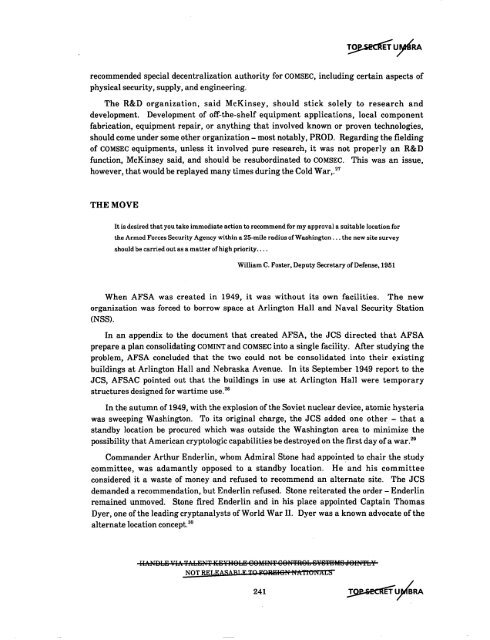American Cryptology during the Cold War - The Black Vault
American Cryptology during the Cold War - The Black Vault
American Cryptology during the Cold War - The Black Vault
Create successful ePaper yourself
Turn your PDF publications into a flip-book with our unique Google optimized e-Paper software.
ecommended special decentralization authority for COMSEC, including certain aspects of<br />
physical security, supply, and engineering.<br />
<strong>The</strong> R&D organization, said McKinsey, should stick solely to research and<br />
development. Development of off-<strong>the</strong>-shelf equipment applications, local component<br />
fabrication, equipment repair, or anything that involved known or proven technologies,<br />
should come under some o<strong>the</strong>r organization - most notably, PROD. Regarding <strong>the</strong> fielding<br />
of COMSEC equipments, unless it involved pure research, it was not properly an R&D<br />
function, McKinsey said, and should be resubordinated to COMSEC. This was an issue,<br />
however, that would be replayed many times <strong>during</strong> <strong>the</strong> <strong>Cold</strong> <strong>War</strong>,.27<br />
THE MOVE<br />
Itis desired that you take immediate action to recommend for my approval a suitable location for<br />
<strong>the</strong> Armed Forces Security Agency within a 25-mile radius ofWashington ... <strong>the</strong> new site survey<br />
should be carried out as a matter ofhigh priority....<br />
William C. Foster, Deputy Secretary of Defense, 1951<br />
When AFSA was created in 1949, it was without its own facilities. <strong>The</strong> new<br />
organization was forced to borrow space at Arlington Hall and Naval Security Station<br />
(NSS).<br />
In an appendix to <strong>the</strong> document that created AFSA, <strong>the</strong> JCS directed that AFSA<br />
prepare a plan consolidating COMINT and COMSEC into a single facility. Mer studying <strong>the</strong><br />
problem, AFSA concluded that <strong>the</strong> two could not be consolidated into <strong>the</strong>ir existing<br />
buildings at Arlington Hall and Nebraska Avenue. In its September 1949 report to <strong>the</strong><br />
JCS, AFSAC pointed out that <strong>the</strong> buildings in use at Arlington Hall were temporary<br />
structures designed for wartime use. 28<br />
In <strong>the</strong> autumn of 1949, with <strong>the</strong> explosion of <strong>the</strong> Soviet nuclear device, atomic hysteria<br />
was sweeping Washington. To its original charge, <strong>the</strong> JCS added one o<strong>the</strong>r - that a<br />
standby location be procured which was outside <strong>the</strong> Washington area to minimize <strong>the</strong><br />
possibility that <strong>American</strong> cryptologic capabilities be destroyed on <strong>the</strong> first day ofa war. 29<br />
Commander Arthur Enderlin, whom Admiral Stone had appointed to chair <strong>the</strong> study<br />
committee, was adamantly opposed to a standby location. He and his committee<br />
considered it a waste of money and refused to recommend an alternate site. <strong>The</strong> JCS<br />
demanded a recommendation, but Enderlin refused. Stone reiterated <strong>the</strong> order - Enderlin<br />
remained unmoved. Stone fired Enderlin and in his place appointed Captain Thomas<br />
Dyer, one of <strong>the</strong> leading cryptanalysts of World <strong>War</strong> II. Dyer was a known advocate of<strong>the</strong><br />
alternate location concept. 30<br />
IIMH3bli> VIA 'fAbli>n'f KIi>YII9bli> 69MHf'f 69n'fR9b SYS'fElMS of9IU'fLY<br />
NOT RELEASABI E TO i'QKIi>I6N" U2\'fI"NALS<br />
241
















